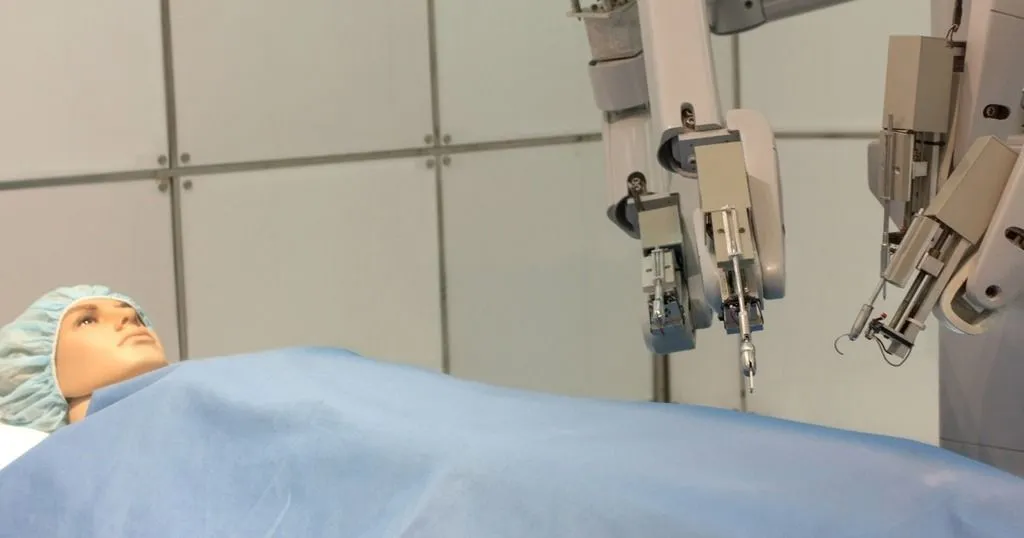Robots in the operating room

Dr. Ahmad and his team analyzed surgical team movements during robot-assisted surgery to understand and categorize causes for interruptions.
Posted by
Published on
Tue 11 Apr. 2017
Topics
| Human Factors | Human-computer Interaction | Human-robot Interaction | Robotics | The Observer XT | Medical Encounter |
Recent developments in robot technology allows robots to handle more and more tasks that previously were only possible for humans. There are robots that are able to vacuum your house or mow the grass; there are self-driving vehicles, or even drones which sends packages through the air. Robots are all around us.
Can a robot replace a surgeon?
A number of surgeries that take place in an operating room (OR) now utilize robots; these include prostatectomies, cardiac valve repair, and gynecologic surgical procedures. Robots have been used in these procedures to improve upon conventional laparoscopy, for quite some time now.
Due to robotic use, these types of surgeries can be done with greater precision, miniaturization, and smaller incisions, which leads to decreased blood loss, less pain, quicker healing time, and shorter hospital stays.
A robot is accurate, stable, and tireless. It is able to make specific movements which are stressful or even impossible for a surgeon.
However, opinions about the use of robot-assisted surgery (RAS) are diverse. There are obvious benefits, but disadvantages as well, such as expense and the large amount of time that must be invested to teach the staff (particularly surgeons) to work with the robot.
The influence of the da Vinci™ in the OR
RAS has changed the traditional OR layout, with equipment occupying more space without a proportionate increase in room size. The additional required hardware, and large size of the equipment, may hinder the flow within the OR.
The da Vinci robot system consists of a surgeon's console that is typically in the operating room (with the patient), as well as a patient-side cart with four interactive robotic arms controlled from the console.
If the da Vinci robot obstructs movement, or causes additional unnecessary movements, operating room teams may have altered team interactions, increased distraction, tension, and frustration, and impaired team performance, all of which could eventually compromise patient safety.
Interruptions to surgical workflow
Dr. Ahmad and his team analyzed surgical team movements during RAS in order to understand and categorize procedural interruptions and to identify modifiable factors that can be eliminated to enhance surgical performance.
Ten robot-assisted radical prostatectomies (removal of the prostate gland) were analyzed retrospectively. Three cameras were used to maximize the coverage of the OR environment, and eight audio tracks were recorded for each team member.
Tracking, observing and coding movements
The OR was divided in eight zones, and all movements were tracked and described in terms of start and end zones, duration, personnel, and purpose. Movements were further classified into avoidable (can be eliminated/improved) and unavoidable (necessary to complete the procedure).
Recordings from the da Vinci™ surgical system, lapel microphones, and video cameras were synchronized. The videos were viewed by a trained medical student and physician assistant student, supervised by a Urology fellow and a human factors engineering expert.
The purpose of each walking motion was established based on visual and audio cues from the recordings. The Observer XT was used to code and analyze the collected data.
Analyzing the movements
A total of 2,896 ambulatory movements were observed. The circulating nurse contributed to the majority of traffic, followed by the lead surgeon.
Overall, procedure-related ambulatory movements (such as receiving/delivering biopsies, paperwork, scrubbing in, and checking on patient progress) were the most common, followed by miscellaneous (e.g. shift changes/breaks, washing hands), and technology-related movements (for example equipment handling, and use of computers/monitors).
Further analysis showed that 50% of these walking movements were avoidable, since they had no positive impact on the surgical procedure, or could have been avoided with a refined OR layout.
Ambulatory movements are considered potential distractions and/or obstacles to surgical flow, which makes the large amount of avoidable ambulatory movements in this study alarming for patient safety.
Improvements needed to guarantee patient safety
Repositioning equipment with optimization of supply areas, along with set-up of needed items before surgery, should be a priority to eliminate the potential flow disruptions that could occur during surgery.
Room layout improvements should target unobstructed views, more efficient locations of computers and monitors, and better access to supplies and equipment, thereby reducing unnecessary movements in the operating room.
Furthermore, simulation training may in evolve in the future to support the surgical staff in optimizing and avoiding unnecessary movements during robot-assisted surgery.
References
- Ahmad, N.; Hussein A.A.; Cavuto, L.; Sharif, M.; Allers, J.C.; Hinata, N.; Ahmad, B.; Kozlowski, J.D.; Hashmi, Z.; Bisantz, A. & Guru, K.A. (2016). Ambulatory movements, team dynamics and interactions during robot-assisted surgery. BJU International, 118, 132-139.
- Allers, J.C.; Hussein, A.A.; Ahmad, N.; Cavuto, L.; Wing, J.F.; Hayes, R.M.; Hinata, N.; Bisantz, A.M. & Guru, K.A. (2016). Evaluation and impact of workflow interruptions during robot-assisted surgery. Urology, 92, 33-37.
Related Posts

Implementing Tailored Activity Programs

Simulation-based training in times of crisis

